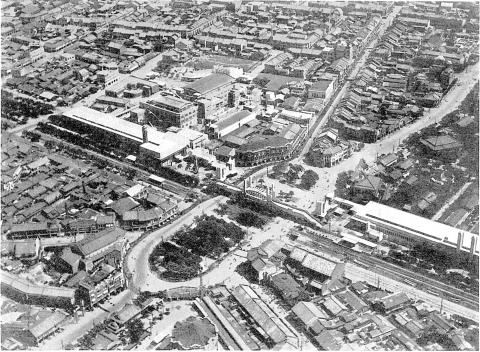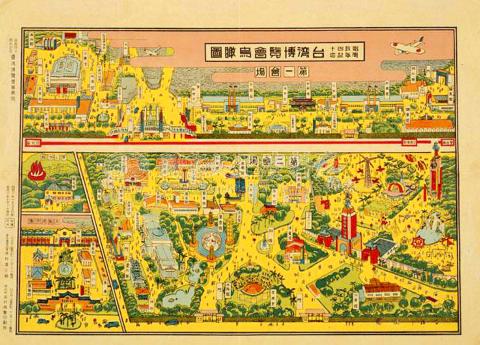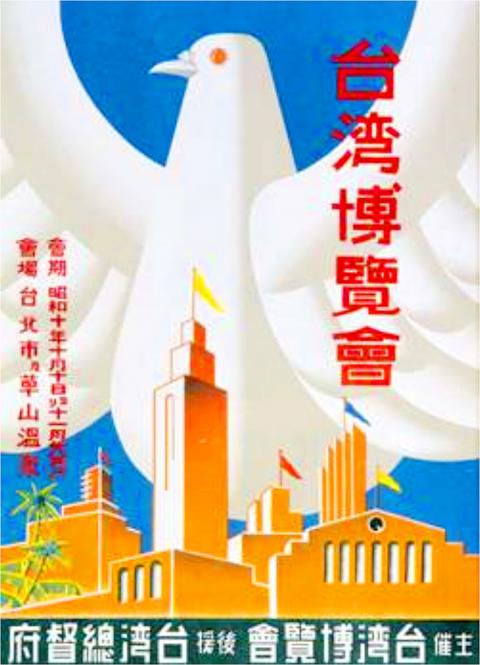Taiwan in Time: Oct. 10 to Oct. 16
On the morning of Oct.10, 1935, after the firing of three gun salutes, 1,500 doves were released into the Taihoku (today’s Taipei) sky as a band played Taiwan Leaping Forward, a Japanese song written especially for the occasion.
For the next 50 days, the entire country would be abuzz with activity as the extravagant and ambitious Taiwan Exhibition held to celebrate 40 years of Japanese rule took place not only in its main Taihoku venues, but with secondary exhibits in numerous cities such as Kirun (Keelung), Takao (Kaohsiung) and Karen (Hualien).

Photo courtesy of Wikimedia Commons
The main exhibition space of more than 130,000m2 was spread across 40 exhibition halls in Taihoku, showcasing more than 300,000 items including the products, industries and latest technologies of Japan, as well as Taiwan and its other colonies, and military, transportation and cultural displays.
The goal was not only for the Japanese to showcase to the world the accomplishments of 40 years of colonization, but it was also a display of might, as they intended to use Taiwan as a springboard for their military “southward expansion” plan (it’s not a coincidence that the exhibition included a whole section devoted to South China and Southeast Asia). Less than a year later, the colonial government began its Japanization program of the Taiwanese people to make them an even more integral part of the empire.
CHEN YI VISITS TAIWAN

Photo courtesy of Wikimedia Commons
The Japanese government invited officials from around the world to attend. One of them was Fujian Province governor Chen Yi (陳儀) — whose name would later be forever etched into Taiwanese history as the governor under whose rule (or misrule) the 228 Incident took place.
Chen enjoyed close ties with Japan as he had lived there for several years as a student and married a Japanese woman, and he had reportedly been tasked by Chinese Nationalist Party (KMT) leader Chiang Kai-shek (蔣介石) to maintain a friendly relationship with Japan. Chen had already sent an observation team to Taiwan in 1934 to use it as a case study of how to bring Fujian out of poverty, noting in a report that despite being much smaller in land area, Taiwan’s production was about six times that of Fujian’s.
On Oct. 21, 1935, Chen became the highest-ranking Chinese official to visit Taiwan during Japanese rule, staying for seven days as he visited the exposition and took a tour showcasing important colonial construction projects. He also met with Taiwan’s governor-general Nakagawa Kenzo and reached an agreement to cooperate economically. In 1936, Chen sent yet another observation team to Taiwan, filing a detailed report to Chiang.

Photo courtesy of Wikimedia Commons
Fo Guang University professor Chen Hsin-yuan (陳信元) writes in his study Chen Yi, Hsu Shou-shang and the Taiwan Provincial Editorial and Translation Bureau (陳儀, 許壽裳 與台灣省編譯館) that to save the Chinese officials face, exhibition staff removed signs mentioning “40 years of colonial rule” when they visited the exhibition. This mutual goodwill did not last long, as Japan would launch a full-scale invasion of China less than two years later.
The real consequence here is that this experience undoubtedly made Chen the prime candidate for governor-general of Taiwan after Japanese defeat, as he was “one of the very few important KMT figures after World War II who had any Taiwan experience,” writes Cheng Chia-hui (程佳慧) in her book The First Major Exposition in Taiwan’s History (台灣史上第一大博覽會).
GARGANTUAN EFFORT
The Japanese put a great amount of effort into this event. In addition to the aggressive promotion and number of people on the planning team, Cheng writes that they set up 46,999 temporary lights in Taihoku — making it the brightest city in Taiwan.
To involve the public, a contest was held for a theme song for the exposition — the top two winning songs were even pressed into records and widely played. Children were encouraged to submit essays about the event which they would read on public radio, and planes dropped about 600,000 fliers over various cities with free tickets and other promotions.
Other more sustainable changes were made, such as a concerted effort to prevent and eradicate typhoid fever and meningitis, which had ravaged the colony earlier that year. The government also improved air, sea and land transportation, and took the opportunity to promote tourism, renovating many historical sites and improving facilities.
Undoubtedly, some Taiwanese denounced the event — in Chu Tien-jen’s (朱點人) short story Autumn Letter (秋信), protagonist Dou Wen (斗文) laments: “The ‘Great Leap Forward of Taiwan’s Productivity’ indeed. Only you Japanese devils can leap forward. I’m afraid Taiwan’s youth don’t even have a chance to inch forward.”
But on the other hand, many local elites and businessmen worked with the Japanese to realize the event. Cheng writes that there were 6,506 Taiwanese members on the roster of the civilian Taiwan Exhibition Support and Sponsor Association (台灣博覽會協贊會). She also estimates that partially due to heavy propaganda and urging by the government, almost half of the Taiwanese population visited the exhibition in Taihoku.
Although Cheng writes that the exposition was “a product of Japanese imperial ambition,” it was also a microcosm of Taiwanese society in the 1930s. There have only been two comparable events in Taiwan’s history — the 1948 Taiwan Province Expo and the 2010 Taipei International Flora Expo.
Taiwan in Time, a column about Taiwan’s history that is published every Sunday, spotlights important or interesting events around the nation that have anniversaries this week.

One of the biggest sore spots in Taiwan’s historical friendship with the US came in 1979 when US president Jimmy Carter broke off formal diplomatic relations with Taiwan’s Republic of China (ROC) government so that the US could establish relations with the People’s Republic of China (PRC). Taiwan’s derecognition came purely at China’s insistence, and the US took the deal. Retired American diplomat John Tkacik, who for almost decade surrounding that schism, from 1974 to 1982, worked in embassies in Taipei and Beijing and at the Taiwan Desk in Washington DC, recently argued in the Taipei Times that “President Carter’s derecognition

This year will go down in the history books. Taiwan faces enormous turmoil and uncertainty in the coming months. Which political parties are in a good position to handle big changes? All of the main parties are beset with challenges. Taking stock, this column examined the Taiwan People’s Party (TPP) (“Huang Kuo-chang’s choking the life out of the TPP,” May 28, page 12), the Democratic Progressive Party (DPP) (“Challenges amid choppy waters for the DPP,” June 14, page 12) and the Chinese Nationalist Party (KMT) (“KMT struggles to seize opportunities as ‘interesting times’ loom,” June 20, page 11). Times like these can

June 23 to June 29 After capturing the walled city of Hsinchu on June 22, 1895, the Japanese hoped to quickly push south and seize control of Taiwan’s entire west coast — but their advance was stalled for more than a month. Not only did local Hakka fighters continue to cause them headaches, resistance forces even attempted to retake the city three times. “We had planned to occupy Anping (Tainan) and Takao (Kaohsiung) as soon as possible, but ever since we took Hsinchu, nearby bandits proclaiming to be ‘righteous people’ (義民) have been destroying train tracks and electrical cables, and gathering in villages

Dr. Y. Tony Yang, Associate Dean of Health Policy and Population Science at George Washington University, argued last week in a piece for the Taipei Times about former president Ma Ying-jeou (馬英九) leading a student delegation to the People’s Republic of China (PRC) that, “The real question is not whether Ma’s visit helps or hurts Taiwan — it is why Taiwan lacks a sophisticated, multi-track approach to one of the most complex geopolitical relationships in the world” (“Ma’s Visit, DPP’s Blind Spot,” June 18, page 8). Yang contends that the Democratic Progressive Party (DPP) has a blind spot: “By treating any